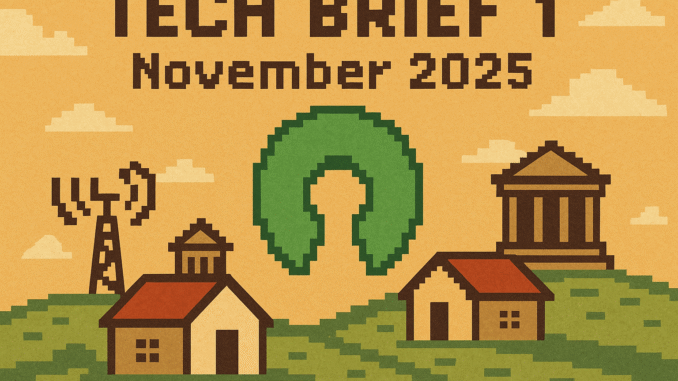
Tech Brief 1 November 2025 lands on a day when British digital policy is finally catching up with decades of technical debt, hacker idealism, and rural neglect. Today we’re looking at a catastrophic IT failure still unfolding in court, the moment open source went from fringe philosophy to government strategy, and £1.9bn committed to connecting the countryside.
Missed yesterday’s Tech Brief? Catch up here before diving in.
Post Office Horizon Defect Remained Undetected for Years, Investigator Warns
A forensic investigator has told the Post Office public inquiry that the Horizon IT defect was serious enough to evade detection for years. The system, developed by Fujitsu and deployed across UK post offices, led to wrongful convictions and financial ruin for hundreds of subpostmasters who were blamed for accounting discrepancies the software itself caused.
This is the nightmare scenario that validates every bit of healthy tech scepticism. Anyone who spent the ’80s debugging temperamental hardware learned early that systems have bugs. Black-box software can fail. But Horizon was declared infallible by people who’d never looked inside the case, and when it inevitably wasn’t, real lives were destroyed.
The inquiry continues to uncover how a system developed for the British Post Office escaped proper scrutiny for so long. It’s a stark reminder that trust in technology should always be conditional, verifiable, and subject to interrogation. No system is above question, especially when human consequences are this severe.
OpenUK Partners with UKRI on Open Source Guidance for Public Sector
Here’s something I didn’t expect to write in 2025: open source ideology is now official UK government policy. OpenUK has partnered with UK Research and Innovation to develop guidance for public sector adoption of open source software, focusing on awareness, community development, and procurement processes. Across Europe, governments are rolling out decentralised, open source secure messaging platforms to reduce reliance on Big Tech for critical communications.
This is vindication for everyone who championed “free as in freedom” when it was still a fringe position. The indie spirit of building your own tools rather than renting from megacorps has become institutional strategy. And frankly, after the Horizon disaster detailed above, the case for transparent, auditable systems that you can actually interrogate feels stronger than ever. Open source won’t prevent every failure, but at least you can see what’s broken and who’s responsible for fixing it.
Building Digital UK Integrated into Department for Science, Innovation and Technology
When did rural broadband finally become a priority? Today, apparently. Building Digital UK, the executive agency responsible for rural broadband and mobile coverage, has been integrated into the Department for Science, Innovation and Technology. The reorganisation maintains £1.9bn in funding commitments for Project Gigabit and the Shared Rural Network.
The numbers are actually impressive. BDUK has already achieved 85% gigabit coverage and 95% 4G coverage ahead of schedule, with a target of 99% gigabit-capable access nationwide by 2032. For context, those who remember the ’90s spent years waiting overnight for a 2MB file to download over dial-up. Bandwidth was precious. Connection was fragile. You learned patience.
Now the government is committing proper resources to ensure rural communities get the connectivity urban areas take for granted. It’s infrastructure with real stakes, the kind that determines whether you can work remotely, access services, or participate in the digital economy. And for those of us running retro computing projects that rely on remote access or online communities, decent rural broadband matters more than you’d think.
Meanwhile, Equinix has acquired a hyperscale datacentre site in Hertfordshire with a £3.9bn investment commitment to the UK. The cloud lives somewhere physical, in racks that consume power and require cooling. British infrastructure is finally attracting the kind of investment that matches the scale of modern computing demands.
From the Wayback Machine
On This Day: 1954: Regency TR-1 Becomes First Commercial Transistor Radio
On 1 November 1954, Industrial Development Engineering Associates released the Regency TR-1, designed by engineer Richard Koch, the first commercially available transistor radio. For $49.95 (about £430 in today’s money), you could slip something the size of a paperback into your pocket and carry music anywhere. Inside its thermoplastic cabinet sat four hand-selected germanium transistors and a battery that lasted over 20 hours. Suddenly, portable didn’t mean “luggable.” It’s the direct ancestor of every portable device we grew up with: Walkmans, Discmans, Game Boys, eventually smartphones. The transition from tubes to transistors changed expectations for consumer electronics forever, proving that compactness and power efficiency could coexist.
What This Means
Tech Brief 1 November 2025 covers three stories about systems, trust, and infrastructure. The Horizon scandal shows what happens when we stop questioning technology. The open source movement becoming government policy suggests we might finally be learning. And rural broadband investment means the connectivity gap is narrowing, even if it’s taken far too long. Sometimes progress is just fixing what should have been done properly the first time. What would those subpostmasters’ lives look like if Horizon’s code had been open to scrutiny from day one? And what innovations are waiting in rural communities once the bandwidth finally arrives?
The best tech is the kind you can interrogate.
Missed yesterday’s Tech Brief? Catch up here.

Leave a Reply